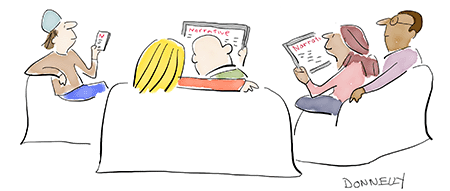Henry Moore is a model for work. I met him first in 1959 when I lived with my family for a year in an English village about fifteen miles from Moore’s house. I had first known Moore for his shelter drawings; and as an undergraduate I thumbtacked to my Eliot House wall a Penguin Print of a study for sculpture. In 1951, coming to Europe for the first time, I saw many of his sculptures outdoors (where they stand in happy competition with the natural world) at the Festival of Britain. In 1959 the American magazine Horizon commissioned me to conduct an interview with him, Paris Review style. That year, on leave without pay from the university, I lived by my wits for the first time—BBC work, reviews for the New Statesman and Encounter, an encyclopedia of poetics co-edited with Stephen Spender—and the interview would contribute to the family budget. I wrote him a letter with the suggestion; he asked me for tea to talk about it, and I took a bus from Thaxted to Bishop’s Stortford seven miles from his house and studios that occupied Hertfordshire farmland. He met the bus in his Rover, generous to take time away from work, and after tea agreed to be interviewed. We met two or three times again, sitting in his living room with a tape recorder between us. He and I played Ping-Pong. He and his wife Irina drove to our house for dinner.
Irina was a beautiful and intelligent woman whom Henry had met when she was an art student and Henry a teacher, who had given up her drawing to concentrate on gardening, who loved silence and solitude. Moore was gregarious by nature, but in their household she led the way: Solitude won out over company, which satisfied another powerful portion of Henry Moore, because he loved dearly to work. If he had married a woman who enjoyed society and conversation, Moore would have wasted his time at parties. He wanted most to get up in the morning, pick up a piece of clay, and work all day into the night. His work was various: modeling new ideas in a little old studio filled with oddly shaped pebbles, old maquettes, and bone; working over waxes that came from the foundry before they returned to become bronzes; carving in stone or wood; sketching; or overseeing assistants, young sculptors who translated models into larger versions—six inches to three feet, three feet to fourteen, fourteen to twenty-seven. Maybe I felt free to hire typists and researchers because Henry hired assistants.
Moore interrupted himself for lunch, tea, drinks, and supper; for mail, although mail was a burden; for the telephone; for the founder’s truck that came to haul away a great plaster for casting. All day he rode a bicycle over his acreage in the rolling farmland, patrolling his studios to work on different projects. At night after supper he and Irina might watch a BBC detective mystery, but as he watched he kept a pad open on his lap and made automatic or random marks in pencil—and sometimes ideas derived from his idle doodles. When I last saw him at eighty he had built a new graphic studio next to the house, where he retreated for an hour after television, working again between nine and ten at night.
Moore did not arrive among the rich and the famous until he was in his forties. Earlier, he had taught for a living, sculpting as much as he could the rest of the day in a Hampstead studio, or at a cottage in the country during holidays. He grew up in Castleford near Leeds, where his father was a coal miner who swore that none of his children would ever go down to the pits. They didn’t—except when Henry sketched coal mining during the Second World War; most of the children taught school, as Henry might have done if he had not served in the Great War and attended art school, first in Leeds and then at the Royal Academy, on something like the G.I. Bill. His whole life felt lucky to him, to have escaped the pits for the studio, to have traded work at the surface of a coal seam for work at the surface of marble and alabaster, of wood and clay.



